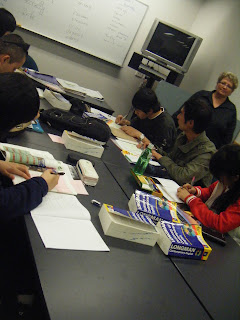วันพุธนี้ตุ๊กได้เข้าไปนั่งดูการสอนของวิชาภาษาอังกฤษทั่วไปซึ่งนักเรียนมีทักษะภาษาอังกฤษอยู่ในขั้นดี วิชานี้นักเรียนจะได้เรียนการอ่าน เขียน พูด แกรมม่า และนอกจากนี้กิจกรรมอื่นๆ ก็มีเหมือนระดับ Beginner-GE 4 ซึ่งมีทั้งชั่วโมงการเรียนด้วยตนเองแต่อยู่ภายใต้การให้คำปรึกษาการเรียนจากอาจารย์ผู้สอน ชั่งโมงห้องแล็ป มีการเน้นการออกเสียง การสะกดคำ และคำศัพท์ การนำเอาสัญลักษณ์ทางภาษาศาสตร์มาสอนนักเรียนถือว่าเป็นประโยชน์ต่อนักเรียนในทุกระดับ เพราะนักเรียนจะสามารถพัฒนาการออกเสียงของเขาเอง ทำให้สำเนียงดีตามไปด้วย นอกจากนี้การสะกดคำจากการดูรูปแบบของคำยังเป็นเทคนิคที่น่าสนใจในการทำให้นักเรียนได้สามารถพัฒนาการสะกดคำได้ นักวิชาการที่นี่เชื่อกันว่าเทคนิคนี้ทำให้นักเรียนไม่ต้องท่องจำการสะกดคำ หรือการอ่านมากนัก นักเรียนสามารถหาคำศัพท์จาก dictionary (English-English) และอ่านได้ง่ายขึ้น ที่นี่เขาสนับสนุนให้นักเรียนใช้พจนานุกรมภาษาอังกฤษ-ภาษาอังกฤษ สำหรับนักเรียนที่มีทักษะภาษาอังกฤษระดับสูงหน่อย แต่ถ้าเป็นระดับเริ่มต้นก็จะอนุโลมให้ใช้พจนานุกรมสองภาษา
Wednesday 17 June 2008. In the afternoon, I observed and assisted a teacher in GE 5 level. This is an advanced level course which contains Integrated Skills, Reading and Writing, Speaking Listening, SAC, Language Lab and Computer Lab. Today, they had Spelling and Vocabulary and Spelling and Pronunciation lesson. Students had some vocabulary background on their week's theme based on the book titled .......so basically what we did in the class was introduce them to a new way of spelling and pronunciation.
Normally, students, in general, learn new vocabulary words and pronounce them by memorising; however, this new method is using phonetic symbols to enhance their pronunciation and using shapes of words to master their spelling. We covered some of the phonetic symbols for vowels and diphthongs sounds such as /e/(leg), /I/(sit), /u/(put),/ /(about),/e /(there), /eI/(play), /OI/(boy),/ u/(go), /aI/(my), and /au/(now). Here, we had students listen to the audio and then complete the exercise on matching words to the right phonetic symbols. Then, we had them added more words. What the students get out of the practice is that they are able to enunciate words clearly which help with their pronunciation and are able to read words in an English-English dictionary more productively and effectively. Then, another lesson was started. The teacher drew a shape of a word (or a box that goes the same shape as a word), then wrote 6 words on the board and had the students guess which word would fit in the shape. Once the students got the "feel," the teacher explained the concept (here the pattern of the practice goes engaging, studying then activating). We separated students into 2 groups (since there are only 6 students in the class, so we had a group of 3)and handed them 9 pieces of two different colored-papers each side (each student in one team had 3 pieces of paper with the same color). Then, they had to choose a word from their previous lesson for each paper and drew a shape on it. Once they finished, they gave their cards with the shapes or patterns of the words and had a member of the other team figure out the word that matches the shape. Here, students learned their spelling by using recognition of word's pattern and take a guess and acknowledged the word endings (put letters together and recognize that 'g' usually goes with 'y' or 's' usually goes with 't'). Also, they practiced their communicative skills by asking questions.
In conclusion, students have to think of combination of words that go together, the pattern of a word and how it looks, so students won't have to memorize the spelling of a word.
Here, I totally agree with the program creator. Introducing students to phonetic symbols and vocabulary pattern is certainly a tool for them to improve their pronunciation and spelling. It would be ideal if we employ this strategy/practice with all students across curriculum on campus
Wednesday, June 18, 2008
Using Phonetic Symbols and Spelling Patterns with Pronunciation and Spelling.
Subscribe to:
Post Comments (Atom)








No comments:
Post a Comment